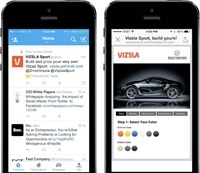A s Facebook
and Twitter increasingly refashion content and advertising for mobile screens, this has created an opportunity for mobile rich media companies to play a bigger role on the two largest social media
platforms.
s Facebook
and Twitter increasingly refashion content and advertising for mobile screens, this has created an opportunity for mobile rich media companies to play a bigger role on the two largest social media
platforms.
Aiming to capitalize on that trend, PointRoll is extending its rich media ad tools to Facebook and Twitter with a new platform for adding video, animation, games and other interactive features to ads within the stream of updates a user sees on both sites.
The company’s Social Engager offering basically allows marketers to turn formats like Page Post Ads on Facebook or Promoted Tweets on Twitter into rich media units, with thumbnail images or videos inside the in-stream ads that link to multimedia posts or ad landing pages. The ads can power sweepstakes, polls, and data feeds, among other things.
On Facebook, the rich media tools can also be used for non-paid placements in the form of Page posts, posts on behalf of a user who has granted a brand access to their profile and friend list, and custom event RSVPs. PointRoll also promises reporting that normalizes social metrics across different media platforms.
Prior to the launch of Social Engager, the company says it has been running a year-long pilot on Facebook on behalf of a major CPG company. The client has run four campaigns in that time. Among PointRoll’s rich media competitors on Facebook is Celtra, which has a badge for expertise in applications through the social network’s Preferred Marketing Developer (PMD) program.
Adding features to news feed ads doesn’t guarantee better results. Facebook in January added more call-to-action options to the lower right-hand corner of Page Post ads including “Shop Now,” “Learn More,” “Sign Up,” “Book Now” or “Download.”
A recent test by Electronic Merchant Systems, however, indicated the buttons don’t necessarily lead to a better return-on-investment.
An ad for the company’s Square-like phone attachment for accepting credit cards that ran without a call-to-action button had cost-per-conversion of $40. The same ad using the “Lear More,” and “Sign Up,” buttons in separate ads, delivered cost-per-conversions of $44 and $42.10, respectively.
An Electronic Merchant Systems executive surmised the ads with call-to-action buttons didn’t perform as well because the feature tipped off users more quickly that they were viewing an ad--rather than updates from a friend or acquaintance—reducing the ad’s effectiveness. If nothing else, it raises a question about how well rich media elements combine with native ad formats.


